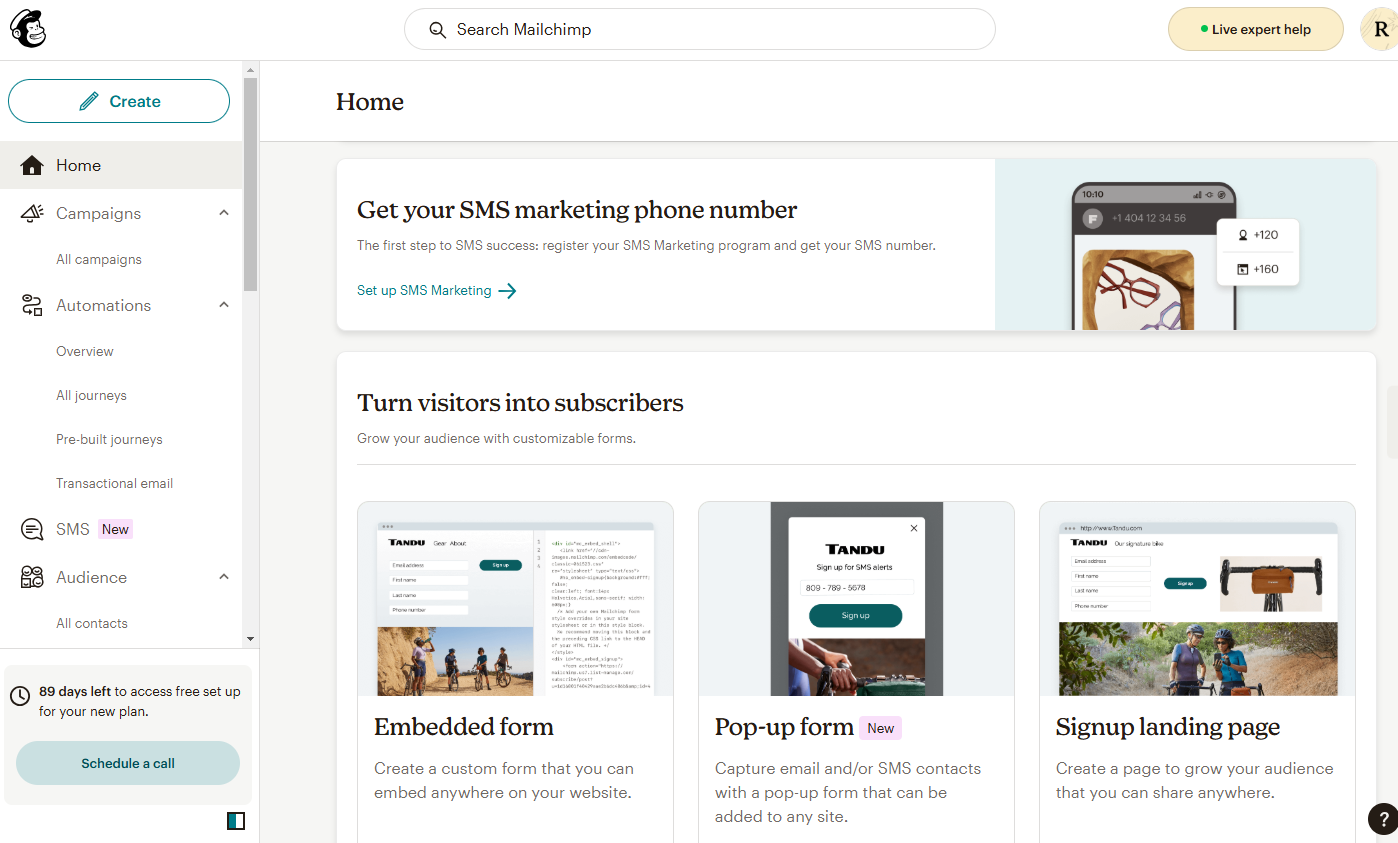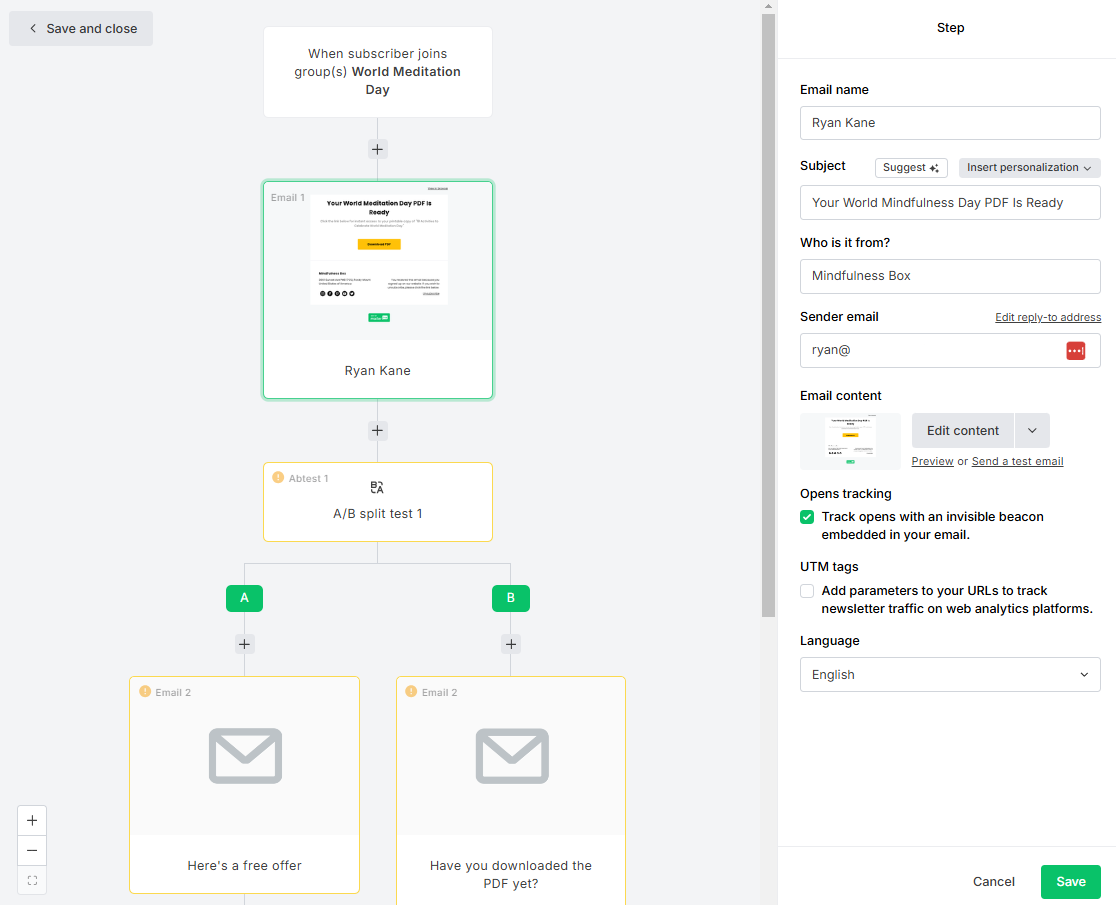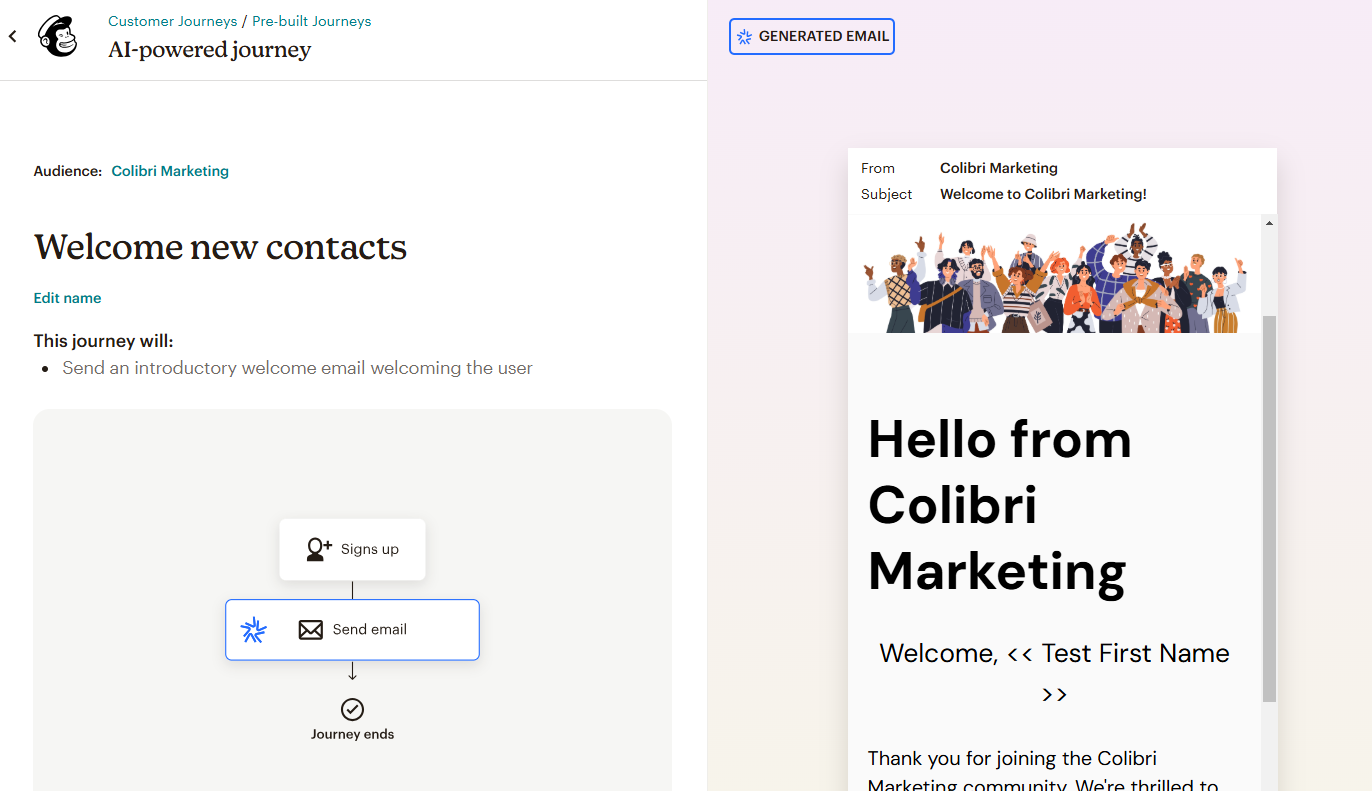Mailchimp has reached near-GoDaddy levels of recognition among small businesses: when I worked at a marketing agency, clients either had Mailchimp or they had nothing. But there are plenty of other options for small business email software. One of them is MailerLite, which I switched to myself a couple years back.
I’ve used both platforms extensively, and have also evaluated their features in-depth for my MailerLite review and guide to Mailchimp email automation. In preparation for this head-to-head showdown, I created campaigns in both MailerLite and Mailchimp to compare the design, ease of use, automation, analytics, and latest AI features of both. Here’s what I found.
Table of contents:
MailerLite vs. Mailchimp at a glance
If you’re looking for a quick rundown, here’s the summary:
-
Mailchimp is best for eCommerce stores, brick-and-mortar businesses, and experienced marketers. Mailchimp’s eCommerce integrations are superb, its SMS messages are perfect for local businesses, and its advanced features and AI integrations will make marketers happy.
-
MailerLite is best for beginners and most small businesses on a budget. MailerLite’s free plan is among the best in the industry. It’s easy to use for beginners, while still providing enough features to satisfy most users.
|
Mailchimp |
MailerLite |
|
|---|---|---|
|
Pricing |
⭐⭐ More limited free plan, relatively pricey paid plans, and a Premium plan that costs 10x more than the equivalent MailerLite plan. |
⭐⭐⭐⭐⭐ A full-featured free plan; robust, economical paid plans that will serve most email marketers well. |
|
Design capabilities |
⭐⭐⭐⭐ A clean interface, AI design features, and 120+ email templates give it a slight edge. |
⭐⭐⭐⭐ Drag-and-drop email editor with 90+ templates and predesigned blocks for speedy email creation. Recently improved landing page builder offers slick templates. |
|
Ease of use |
⭐⭐⭐⭐ Easy to use, but the platform’s many features means learning everything takes time. Free 1:1 onboarding call in your first 90 days. |
⭐⭐⭐⭐⭐ Instantly intuitive, even for beginners. Simple dashboard and uncomplicated navigation. |
|
Advanced features |
⭐⭐⭐ It’s not as advanced as some competitors, but Mailchimp shines as an all-in-one marketing tool. |
⭐⭐ MailerLite does email quite well; other features tend to be pretty basic. |
|
Marketing automation |
⭐⭐⭐⭐ More automation templates and triggers than MailerLite—but there’s no automation on the free plan. 100+ automation templates. |
⭐⭐⭐⭐ With automations included for users of the free plan, it’s the best deal around. Only 15 automation templates. |
|
AI features |
⭐⭐⭐⭐ Clever use of AI to speed up email design and content creation, with much more on the roadmap. |
⭐⭐ AI features feel like the bare minimum (“AI subject line generator!”) and only scratch the surface of what’s possible—though MailerLite recently added AI-generated landing pages. |
|
Analytics |
⭐⭐⭐⭐⭐ Advanced eCommerce stats, click maps, Content Optimizer, and more. |
⭐⭐⭐ Only the essentials, but an excellent interface embeds analytics where you most need them. |
|
Integrations |
⭐⭐⭐⭐⭐ 330+ native integrations; also integrates with Zapier. |
⭐⭐⭐⭐⭐ 150+ native integrations; also integrates with Zapier. |
MailerLite provides more value for money—and has a better free plan
A decade ago, Mailchimp was the preeminent “affordable” small business email marketing tool. No more. These days, Mailchimp has expanded into an all-in-one marketing suite. While that has its own benefits—as we’ll explore later—it does mean that Mailchimp has gotten more expensive over time.
At MailerLite, $25/month gets you 2,500 subscribers and unlimited email sends. The equivalent Mailchimp plan costs $60/month and limits the number of emails you can send. (If you go over your monthly send limit, Mailchimp tacks on a surcharge to your bill.) Mailchimp’s once-robust free plan has also gotten a serious haircut: with 500 contacts, 1,000 monthly email sends, and no automations or A/B testing, it’s a significantly throttled version of the full product. If you send more than a couple emails a month, you’ll hit a wall fast.
MailerLite, in some ways, is like 2013-era Mailchimp: a great free plan, affordable paid plans, and a tight focus on email marketing rather than all-in-one marketing features. MailerLite’s excellent free plan gets you 1,000 subscribers and 12,000 monthly email sends, plus email automation capabilities. This will last most users a long time: I used MailerLite’s free plan for over a year before needing to upgrade.
Mailchimp has better templates and design features
While both platforms offer strong design features, Mailchimp has a slight edge overall due to its cleaner user interface, better templates, and AI design technology—though MailerLite caters better to beginners.
MailerLite’s editor has everything you’d expect: drag-and-drop elements, eCommerce widgets, and calls-to-action. Its predesigned sections (like side-by-side image + text) come packed with filler content, making it easy to visualize your email’s layout before adding text and images. Integrated surveys and quizzes are another standout MailerLite feature; subscriber responses are conveniently stored within MailerLite’s platform.

Mailchimp’s features are essentially the same. But it’s less cluttered and easier to navigate than MailerLite since its menu items only occupy one side of the screen. Plus, Mailchimp’s AI-powered Content Optimizer feature gives suggestions on email improvements. Overall, Mailchimp’s email editor feels slightly more advanced, while MailerLite, with its predesigned blocks, caters well to beginners.

Of course, most people don’t design emails entirely from scratch. Instead, they get started with templates and edit from there. Mailchimp has an edge here, with 120 email templates to choose from. MailerLite, meanwhile, has 90. The real question, though, is whether the templates are worth using. Beauty is in the eye of the beholder, of course, but I tend to find Mailchimp’s templates a bit more polished. It’s worth mentioning that free users get the shaft; neither platform offers much in the way of template support unless you pay.

Mailchimp users can also skip templates entirely and use AI instead. You can use Mailchimp’s Creative Assistant tool to generate a unique email design based on your brand guidelines. (I’ll share more about this AI feature, and others, in a bit.) Mailchimp’s AI does a capable job of designing unique emails, and as the technology progresses, it’s easy to see templates becoming less relevant. MailerLite doesn’t have any comparable AI design features; you still have to either use templates or design emails manually.
MailerLite is easier to learn
The “lite” in MailerLite, as the company’s founders explain on their About page, represents the goal of simplifying complex things. When it comes to ease of use, they’ve done their job well: at every turn, MailerLite is uncomplicated, simple to understand, and straightforward to learn.
MailerLite’s dashboard, for example, limits menu items to the core features you need to manage on a regular basis: email campaigns, subscribers, forms, landing pages, and automations. It also provides a handy analytics overview and a recap of your most recent email campaign.

Every part of the MailerLite experience is intuitive, from creating campaigns to managing subscribers and designing landing pages. Automation—because of the number of variables involved—is naturally the trickiest to learn. But MailerLite’s simple automation editor makes this easy, too.
Mailchimp’s individual features are equally intuitive, but in a way, Mailchimp is a victim of its own success here: there are so many tools that navigating through them all takes time. For example, it’s great that Mailchimp supports transactional emails and has an SMS feature that lets you contact users by text; but for new users, the proliferation of advanced options like this can lead to overwhelm.

If you sign up for Mailchimp and need help figuring it out, you can schedule a free 1:1 onboarding call within your first 90 days. (For a mass-market product that gets thousands of new signups per day, this is an impressive offer.)
Mailchimp is more comprehensive as an all-in-one marketing tool
If your intent is to buy email software that can cover your general marketing needs too, Mailchimp fits the bill much better than MailerLite. Mailchimp offers email marketing and landing pages, of course, but it also supports Facebook and Instagram ads, Google remarketing ads, organic social posts, and SMS messages.
I’ll say this: MailerLite is fantastic as an email marketing tool. But the more it strays away from email, the less polished it tends to be. For example, MailerLite’s marketing copy touts its versatility for selling subscriptions and digital products. (“Are you ready to earn passive income? Let’s get started!”) But while you can hack a solution together yourself using a Stripe payment integration and a “Buy now” button, in reality, MailerLite doesn’t have any purpose-built features for selling digital products.
While Mailchimp isn’t the most advanced email marketing tool around—that title probably belongs to Klaviyo or ActiveCampaign—it works much better than MailerLite as a general-purpose marketing tool. Mailchimp’s eCommerce tools feel more polished than MailerLite’s, and nifty features like Appointment Scheduling help businesses do more from within the platform. Mailchimp also serves as a basic CRM, with features like contact-scoring based on each subscriber’s level of interaction and the ability to write notes under each contact.

Websites and landing pages are one area where MailerLite is starting to catch up. It recently relaunched its landing page builder, which now offers slick templates and dozens of prebuilt drag-and-drop sections.

You can also opt for a one-click AI-generated landing page, though in my testing, the outcome wasn’t nearly as nice as what MailerLite’s templates offer.
Mailchimp has more powerful automations, for a price
Mailchimp and MailerLite both have powerful email automation features, but Mailchimp’s are advanced enough to give it an edge—although in my experience, MailerLite’s automation designer is more intuitive.
Using MailerLite to create automations is dead simple. With the visual designer, you can easily construct each step in your automation workflow before going in to edit each individual email. Then, you can fine-tune your automation with features like delays and A/B tests. Conveniently, the analytics stats for each email are built right into the workflow, so you don’t need to go anywhere else to understand how your automation is performing.

Templates are a limitation for MailerLite, though. MailerLite has only 15 automation templates, compared to Mailchimp’s 100+, from Celebrate Mother’s Day to Test which discounts lead to more sales. If you want to create an email automation quickly, Mailchimp is more likely to have what you need.
Once you start modifying your automation template, Mailchimp also boasts more options. This difference is especially stark in the case of eCommerce: Mailchimp lets you drop people into the automation based on variables like buys a specific product, abandons cart, time since last purchase, and chat finished in LiveChat account. Mailchimp’s visual builder might be more complex than MailerLite’s, but the end result is more power and flexibility.

It’s worth noting, however, that while MailerLite offers automation in its free plan, Mailchimp’s free users miss the automation party entirely. Even Mailchimp’s Essentials plan only allows four “journey points,” meaning you need to upgrade to Mailchimp’s Standard plan to get free reign on automations.
Mailchimp makes much better use of AI
MailerLite’s AI features—an AI subject line generator and an AI writing assistant—are hard to get excited about. They work well enough, but AI writing tools have offered these features for years. MailerLite is slowly growing its AI capabilities and now offers an AI-powered landing page builder, but overall, there aren’t many features that actually boost your email marketing productivity.
Mailchimp is more thoughtful about how to apply AI to the world of email marketing. For example, Mailchimp’s Creative Assistant tool proactively generates AI-powered designs for you based on your brand.

Mailchimp’s Intuit Assist AI assistant, currently in beta, can make suggestions for subject lines and write parts of your email for you. It’s nothing too groundbreaking, but I appreciated the ability to quickly generate ideas, rewrite sections, and adjust your tone of voice.

My favorite of Mailchimp’s AI features—and the one that will probably save you the most time—is its AI-powered customer journeys. While Mailchimp isn’t the first email marketing tool to use AI for automations, it’s the first I’ve seen that also generates brand-appropriate emails for each step in the sequence. While there are only a few AI-powered journeys available so far, like Welcome new customers and Recover lost customers, this feature has tons of potential.

Mailchimp also has bigger AI plans, including a “revenue intelligence” feature that predicts when customers will be ready to convert. But this feature has been in the works for at least a year with no sign of release yet, so if you’re in urgent need of AI-powered eCommerce insights, you’ll be better served by a tool like Klaviyo.
I do have a bone to pick with Mailchimp’s AI features: they’re oddly tough to access. Despite having been released in mid-2023, they’re still in beta, and are only available to users with a U.S. mailing address who are on Mailchimp’s Standard plan or above. Even if you meet those requirements, access is spotty. When I signed up for a new test account while writing this article, AI features were nowhere to be found. I had to endure a 45-minute support chat with Mailchimp to enable them. (Apparently, the problem was that I selected consulting as my industry, which turned out to be “one of the industries that is restricted from using AI” by Mailchimp. Go figure.)
Mailchimp’s analytics are more robust
If you’re looking for simple, well-presented analytics, MailerLite is hard to beat. But beyond looking at beautiful charts of your subscriber count and open rate, there’s not too much else you can do. Mailchimp is a better choice for power users, offering powerful analytics and custom reports.
MailerLite’s edge is its user interface. Its analytics tend to show up contextually, which means they’re always right where you need them to be: for example, the analytics below are baked right into each email in my MailerLite automation workflow. By jumping between emails in the workflow, I can quickly understand how each is performing.

But if you want to dig much deeper, you’ll run into limitations with MailerLite. Mailchimp, by contrast, allows you to run detailed performance comparisons and generally offers a deeper level of insights. Mailchimp is a better choice if analytics are important to you, with better demographic reporting, powerful custom reports, and features like Content Optimizer, which gives suggestions to improve your email based on businesses in similar industries.

Both have an impressive number of integrations
Both apps have numerous native integrations: MailerLite has 150+ and Mailchimp has 330+. And both MailerLite and Mailchimp integrate with Zapier, allowing you to connect with pretty much any app you can imagine. That means you can do things like automatically add new leads based on form submissions or purchases, or save subscriber info to a database or spreadsheet.
Learn more about how to automate Mailchimp or how to automate MailerLite, or get started with one of these pre-made workflows.
Zapier is a no-code automation tool that lets you connect your apps into automated workflows, so that every person and every business can move forward at growth speed. Learn more about how it works.
MailerLite vs. Mailchimp: Which should you choose?
Whether MailerLite or Mailchimp works better for you depends, of course, on what you need. If you’re on the fence, here are some guidelines to help you decide.
Go with MailerLite if you want value and simplicity. Its generous free plan, intuitive interface, and solid email marketing features make it perfect for small businesses and beginners. With MailerLite’s significantly lower price point, built-in automation capabilities (even for users on the free plan), and straightforward analytics, it’s a great choice if you want powerful email marketing without the complexity or cost of an all-in-one platform.
Go with Mailchimp if your priority is comprehensive marketing features and AI capabilities. While its paid plans cost more, you’ll get advanced design tools, 100+ automation templates, and impressive AI features. Its all-in-one marketing suite—including SMS, eCommerce, and social ads—along with detailed analytics and CRM features make Mailchimp perfect for growing businesses that need an all-purpose marketing tool.
Related reading:
This article was originally published in November 2023. The most recent update was in January 2025.